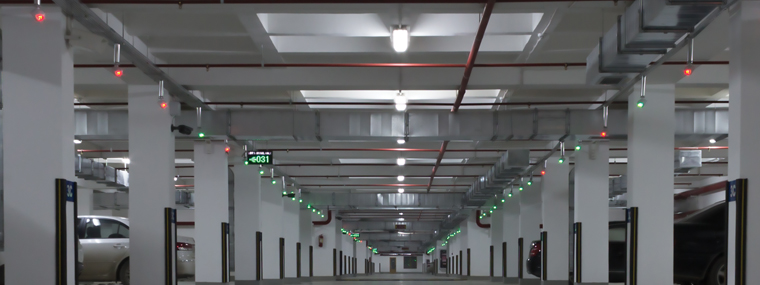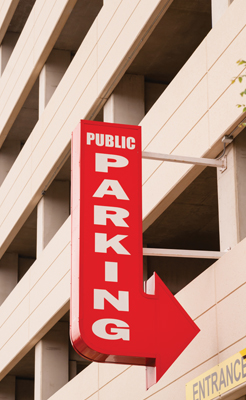
Pressure Washer’s Guidebook: Cleaning Parking Garages
Contributor: Ben Shrope, Owner, President, and Founder, Mechanized Cleaning Solutions Inc., Redmond, WA / Published December 2016

This entry contains some information from the chapters “Flat Surface Cleaning” by Rick Carey, ARK Pressure Washing, and “Shopping Malls”—uncredited, in the 2002 Power Washer’s Guidebook.
Geographical Considerations
Adjoining municipalities may have different regulations for handling wastewater. Each public water system must meet all expectations and permitting requirements of the National Pollution Discharge Elimination System (NPDES), which is an outgrowth of the Clean Water Act of 1987. However, public water systems vary in how they meet the requirements. Know the rules that apply at a particular location and follow them.
Typical Job
One of the most difficult and dangerous projects a pressure washing contractor can take on—and get really good at—is cleaning a parking garage. There is no right formula or procedure; there is only right now.
The most important tool or piece of equipment you can bring is your brain and your ability to pay attention to what is happening in the environment you are in because of the number of significant variables in this setting.
Parking garages in general, and every one specifically, will unforgivingly test, in every way possible, your ability to pay attention and react intelligently to your environment.
Have you scored a big garage? Congratulations! You have just assumed responsibility for a minefield of potential disaster, and every single as-yet-to-be-manifested atom of that potential is invisible to you.
Techniques That Work Best
The first and most obvious problem you’ll have to deal with is maneuvering into the structure, positioning your equipment, and setting up. This, though, just points to your next problem. If it’s an enclosed descending structure, the way the air moves (or doesn’t) can determine how you advance through a project.
Ideally you’d like to start from the top and work down with your equipment behind you. Every single thing you do matters, even where you park the trucks. But if the exhaust fans are on the bottom-most level, you may have to work from the bottom up to keep the exhaust gases behind you so nobody tips over from carbon monoxide poisoning.
Assessing the impact of carbon monoxide exposure during the bid and reconnaissance is just as important as assessing where the water supply is or the closure plan for the different levels or the way traffic will necessarily have to move through your work areas at times.
You don’t want impatient people running over your hoses, but you can stitch them to the ceilings and create a little vehicle pass-through bridge where they can drive under them at one spot in the drive lane.
Is the burner on your hot water skid as far from the nearest sprinkler head as it can be? Does being one pillar over in the next drive lane make running the water hoses or the wastewater discharge hoses way easier? Pay attention. Everything matters.
 Generally speaking, pressure washing parking garages is not pressure washing. Pressure washing is a concept in your head; cleaning parking garages is industrial surface cleaning with integrated wastewater capture.
Generally speaking, pressure washing parking garages is not pressure washing. Pressure washing is a concept in your head; cleaning parking garages is industrial surface cleaning with integrated wastewater capture.
Wastewater reclamation is sometimes vacuuming up peanut butter or hydro-excavation. A couple of employees with good leaf blowers who know how to use them are better than a sweeper truck. But this is dangerous, too, because leaf blowing in a garage may potentially expose the team to carcinogenic particulate matter. And the machines blow wet, not dry.
Trim your structure with wands and get all the gum melted and make sure all the dirt and dust is bound with just the right amount of moisture so it can be moved with blowers into swept piles but stay on the ground and not in the air. Besides, that dust will set off the fire alarms, and then you need to stop for two hours and apologize to the fire department.
Now that the walls and maybe even the ceilings are clean, you were smart enough to not spray the sprinkler heads and overhead electrical fixtures and lighting, the gum is all melted, and the floors have been prepped for surface cleaning with leaf blowers—it’s time to start surface cleaning.
Set those pressure and vacuum hoses together flat and stacked up in 50 feet bends that will come off the hose pile smoothly. Keep 50 feet of loose slack behind your surface cleaner so you don’t yank on the fittings sideways—200 feet of vacuum and pressure hose on an already heavy vacuum surface cleaner will not let you do this long.
Keep your eyes moving all the time in 360 degrees around you, and get good at also listening to the tone and pitch of your engines and pumps and blowers. That deafening noise will tell you what’s going on with your machinery. This pressure washing will cultivate the quality of your attention and your physical awareness.
Exceptions
Every job demands situational awareness. This work is hard and dangerous, and things can go so wrong so quickly. If you’re successful at cleaning garages, it will be because your awareness of your surroundings and your physical senses grew with the rest of your business. Financially, you won’t survive if they don’t. Learn to put your focus on many things at the same time as best you can.
Equipment and Supplies
There are many options, tailored to what the operator identifies on site (e.g., asphalt or concrete) and how much cleaning is needed (e.g., just ordinary dirt accumulation or significant hydrocarbon residue).
Cold water and hot water pressure washers may both be used, depending on the amount of cleaning that must be done. Wands will be required for edges, corners, and pillars, in conjunction with a flat surface cleaner.
A wastewater collection system may be installed in garages. Many newer garages will have specific drains that can be used for wastewater. Storm drain plugs will be needed for portals that cannot be used. Dams or dikes may also be needed to ensure wastewater runoff heads in the direction of the sanctioned drains.
How To Bill
Many garage owners (e.g., municipal government, hospitals, apartments) award contracts on the basis of responses to an RFP (request for proposal). Part of the response required will be proof of insurance, bonding, and so on. Be prepared to meet the requirements.
For one-time, one-garage projects, estimate based on square footage and cost per cleaning each square foot. That cost should include labor, equipment, and fuel. If garage pillar supports are part of the job, be sure to carefully evaluate how long it will take to clean each support.
Ancillaries
Sidewalks leading to or from the parking garage, trash bins, and dumpster areas may be ancillaries. In some cases, cleaning them might be specified as part of an RFP.
Problem Areas to Avoid
Grease and oil spots may require pretreatment. If using a chemical, this will add to the precautions that must be taken to be in compliance with environmental regulations. It will also require adding time. (See sidebar.)
How to Fix Mistakes
Get it right or do it over. It’s not difficult to miss the side of one pillar, so go back and clean it. Customers really appreciate it, too, when somebody is wakeful, present, aware and listening to them. Let the hard work and the problems and the mistakes and the difficulties do their work on you. It will pay off if you stay focused because before long you will find yourself one of the few very reliable men in town known for the quality of his word and his work.
Ben Shrope is owner, president, and founder of Mechanized Cleaning Solutions Inc., a mobile cleaning and maintenance company based in Redland, WA, which offers expert cleaning and reclamation solutions for clients.
Grease is a Challenge
Contributor: Dion McGuffee, Owner, Eco Power Wash Inc., Magnolia TX
Cleaning areas with grease can prove to be challenging. Commercial power washing involving food establishments most likely will have issues with high foot traffic and disposal areas. There are several tips that will reduce the time involved and should provide better outcomes.
Pretreating the area with a degreaser will start breaking down the grease prior to starting the washing process. We use a mixture of EBC and Dragon Juice in a pump-up sprayer to pretreat. Areas near cooking grease dumpsters are saturated as are “paths” from the establishment to the dumpster.
Investing in a hot water machine will also improve the wash results. Our company uses a Water Dragon on most commercial sites. Water temperatures between 180 and 200 degrees will dissolve grease. Always take special care to wear protective gear to avoid burns.
Post treating an area, especially around grease disposal areas, will slow down the absorption of grease between cleanings, too. Simply apply a light mist of pretreat mix following the wash process.
Cleaning grease on concrete can prove to be challenging, but with the right products and equipment the outcomes can be rather dramatic.
Eco Power Wash Inc., is a veteran-owned and family-operated power washing company based in Magnolia, TX. We started our business with a very simple business model: To provide superior cleaning at a fair and reasonable price. We are members of UAMCC and the Magnolia Chamber of Commerce.






